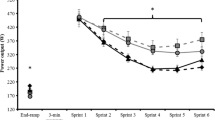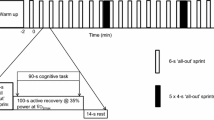Abstract
Introduction
The aim of this study was to investigate the effect of acetaminophen on repeated sprint cycling performance.
Methods
Nine recreationally active male participants completed a graded exercise test, a familiarisation set of Wingate Anaerobic Tests (WAnTs) and two experimental sets of WAnTs (8 × 30 s sprints, 2 min active rest intervals). In the experimental WAnTs, participants ingested either 1.5 g acetaminophen or a placebo in a double-blind, randomised, crossover design. During the WAnT trials, participants provided ratings of perceived pain 20 s into each sprint. Mean and peak power output and heart rate were recorded immediately following each sprint, and percentage decrement in mean power output was subsequently calculated.
Results
Participants cycled at a significantly greater mean power output over the course of 8 WAnTs (p < 0.05) following the ingestion of acetaminophen (391 ± 74 vs. 372 ± 90 W), due to a significantly greater mean power output during sprints 6, 7 and 8 (p < 0.05). Percentage decrements in mean power output were also significantly reduced (p < 0.05) following acetaminophen ingestion (17 ± 14 vs. 24 ± 17 %). No significant differences in peak power output, perceived pain or heart rate were observed between conditions.
Conclusion
Acetaminophen may have improved performance through the reduction of pain for a given work rate, thereby enabling participants to exercise closer to a true physiological limit. These results suggest that exercise may be regulated by pain perception, and that an increased pain tolerance can improve exercise performance.




Similar content being viewed by others
Abbreviations
- 5-HT:
-
Serotonin
- ACT:
-
Acetaminophen/paracetamol
- CI:
-
Confidence intervals
- CNS:
-
Central nervous system
- HR:
-
Heart rate
- MPO:
-
Mean power output
- PPO:
-
Peak power output
- RSE:
-
Repeated sprint exercise
- TRPA1:
-
Transient receptor potential cation channel, subfamily A, member 1
- \({\dot{\text{V}}\text{O}}_{2\hbox{max} }\) :
-
Maximal oxygen consumption
- W:
-
Watts
- WAnT:
-
Wingate anaerobic test
- W dec :
-
Percentage decrement in mean power output
References
Amann M, Proctor LT, Sebranek JJ, Pegelow DF, Dempsey JA (2009) Opioid-mediated muscle afferents inhibit central motor drive and limit peripheral muscle fatigue development in humans. J Physiol 587:271–283. doi:10.1113/jphysiol.2008.163303
Andersson DA, Gentry C, Alenmyr L, Killander D, Lewis SE, Andersson A, Bucher B, Galzi JL, Sterner O, Bevan S, Hogestatt ED, Zygmunt PM (2011) TRPA1 mediates spinal antinociception induced by acetaminophen and the cannabinoid Delta(9)-tetrahydrocannabiorcol. Nature Commun 2:551. doi:10.1038/ncomms1559
Ansley L, Robson PJ, Gibson ASC, Noakes TD (2004) Anticipatory pacing strategies during supramaximal exercise lasting longer than 30 S. Med Sci Sports Exerc 36:309–314. doi:10.1249/01.mss.0000113474.31529.c6
Bertolini A, Ferrari A, Ottani A, Guerzoni S, Tacchi R, Leone S (2006) Paracetamol: new vistas of an old drug. CNS Drug Rev 12:250–275. doi:10.1111/j.1527-3458.2006.00250.x
Billaut F, Bishop DJ, Schaerz S, Noakes TD (2011) Influence of knowledge of sprint number on pacing during repeated-sprint exercise. Med Sci Sports Exerc 43:665–672. doi:10.1249/MSS.0b013e3181f6ee3b
Bogdanis GC, Nevill ME, Boobis LH, Lakomy HK, Nevill AM (1995) Recovery of power output and muscle metabolites following 30 s of maximal sprint cycling in man. J Physiol 482:467–480
Bonnefont J, Alloui A, Chapuy E, Clottes E, Eschalier A (2003a) Orally administered paracetamol does not act locally in the rat formalin test: evidence for a supraspinal, serotonin-dependent antinociceptive mechanism. Anesthesiology 99:976–981
Bonnefont J, Courade JP, Alloui A, Eschalier A (2003b) Antinociceptive mechanism of action of paracetamol. Drugs 63:1–4
Boutaud O, Aronoff DM, Richardson JH, Marnett LJ, Oates JA (2002) Determinants of the cellular specificity of acetaminophen as an inhibitor of prostaglandin H(2) synthases. Proc Natl Acad Sci USA 99:7130–7135. doi:10.1073/pnas.102588199
Bradley AL, Ball TE (1992) The Wingate Test: effect of load on the power outputs of female athletes and nonathletes. J Appl Sport Sci Res 6:193–199
Burke A, Smyth E, Fitzgerald GA (2006) Analgesic–antipyretic agents; pharmacotherapy of gout. Goodman and Gilman’s the pharmacological basis of therapeutics. McGraw-Hill, New York
Calbet JA, Chavarren J, Dorado C (1997) Fractional use of anaerobic capacity during a 30- and a 45-s Wingate test. Eur J Appl Physiol Occup Physiol 76:308–313
Chandler JV, Blair SN (1980) The effect of amphetamines on selected physiological components related to athletic success. Med Sci Sports Exerc 12:65–69. doi:10.1249/00005768-198021000-00013
Cook DB, O’Connor PJ, Eubanks SA, Smith JC, Lee M (1997) Naturally occurring muscle pain during exercise: assessment and experimental evidence. Med Sci Sports Exerc 29:999–1012 (pii: 00005768-199708000-00004)
Dube JA, Mercier C (2011) Effect of pain and pain expectation on primary motor cortex excitability. Clin Neurophysiol 122:2318–2323. doi:10.1016/j.clinph.2011.03.026
Garcin M, Mille-Hamard L, Billat V, Humbert L, Lhermitte M (2005a) Influence of acetaminophen consumption on perceived exertion at the lactate concentration threshold. Percept Mot Skills 101:675–683. doi:10.2466/pms.101.3.675-683
Garcin M, Mille-Hamard L, Billat V, Imbenotte M, Humbert L, Lhermitte Z (2005b) Use of acetaminophen in young sub elite athletes. J Sports Med Phys Fit 45:604–607
Girard O, Mendez-Villanueva A, Bishop D (2011) Repeated-sprint ability: part I: factors contributing to fatigue. Sports Med 41:673–694. doi:10.2165/11590550-000000000-00000
Grafen G, Hails R (2002) Modern statistics for life sciences. Oxford University Press, New York
Hudson GM, Green JM, Bishop PA, Richardson MT (2008) Effects of caffeine and aspirin on light resistance training performance, perceived exertion, and pain perception. J Strength Cond Res 22:1950–1957. doi:10.1519/JSC.0b013e31818219cb
Laaksonen R, Fogelholm M, Himberg JJ, Laakso J, Salorinne Y (1995) Ubiquinone supplementation and exercise capacity in trained young and older men. Eur J Appl Physiol Occup Physiol 72:95–100. doi:10.1007/BF00964121
Makin AJ, Williams R (1997) Acetaminophen-induced hepatotoxicity: predisposing factors and treatments. Adv Intern Med 42:453–483
Mauger AR, Hopker JG (2013) The effect of acetaminophen ingestion on cortico-spinal excitability. Can J Physiol Pharmacol 91:187–189. doi:10.1139/cjpp-2012-0213
Mauger AR, Jones AM, Williams CA (2009) Influence of feedback and prior experience on pacing during a 4-km cycle time trial. Med Sci Sports Exerc 41:451–458. doi:10.1249/MSS.0b013e3181854957
Mauger AR, Jones AM, Williams CA (2010) Influence of acetaminophen on performance during time trial cycling. J Appl Physiol 108:98–104. doi:10.1152/japplphysiol.00761.2009
Mauger A, Neuloh J, Castle P (2012) Analysis of pacing strategy selection in elite 400-m freestyle swimming. Med Sci Sports Exerc 44:2205–2212. doi:10.1249/MSS.0b013e3182604b84
McGawley K, Bishop D (2006) Reliability of a 5 × 6-s maximal cycling repeated-sprint test in trained female team-sport athletes. Eur J Appl Physiol 98:383–393. doi:10.1007/s00421-006-0284-8
Mendez-Villanueva A, Hamer P, Bishop D (2007) Physical fitness and performance. Fatigue responses during repeated sprints matched for initial mechanical output. Med Sci Sports Exerc 39:2219–2225. doi:10.1249/mss.0b013e31815669dc
Mohr M, Nordsborg N, Nielsen JJ, Pedersen LD, Fischer C, Krustrup P, Bangsbo J (2004) Potassium kinetics in human muscle interstitium during repeated intense exercise in relation to fatigue. Pflugers Arch 448:452–456. doi:10.1007/s00424-004-1257-6
Motl RW, O’Connor PJ, Tubandt L, Puetz T, Ely MR (2006) Effect of caffeine on leg muscle pain during cycling exercise among females. Med Sci Sports Exerc 38:598–604. doi:10.1249/01.mss.0000193558.70995.03
Noakes TD, St Clair Gibson A, Lambert EV (2005) From catastrophe to complexity: a novel model of integrative central neural regulation of effort and fatigue during exercise in humans: summary and conclusions. Br J Sports Med 39:120–124. doi:10.1136/bjsm.2003.010330
O’Connor PJ (1992) Psychological aspects of endurance performance. In: Astrand PO (ed) Endurance in Sport. Blackwell Science, Oxford
O’Connor PJ, Cook DB (1999) Exercise and pain: the neurobiology, measurement, and laboratory study of pain in relation to exercise in humans. Exerc Sport Sci Rev 27:119–166 (pii:00003677-199900270-00007)
Plaskett CJ, Cafarelli E (2001) Caffeine increases endurance and attenuates force sensation during submaximal isometric contractions. J Appl Physiol 91:1535–1544
Roi GS, Garagiola U, Verza P, Spadari G, Radice D, Zecca L, Cerretelli P (1994) Aspirin does not affect exercise performance. Int J Sports Med 15:224–227. doi:10.1055/s-2007-1021050
Ross EZ, Gregson W, Williams K, Robertson C, George K (2010) Muscle contractile function and neural control after repetitive endurance cycling. Med Sci Sports Exerc 42:206–212. doi:10.1249/MSS.0b013e3181b07a18
Sahlin K, Ren JM (1989) Relationship of contraction capacity to metabolic changes during recovery from a fatiguing contraction. J Appl Physiol 67:648–654
Sawrymowicz M (1997) The effect of exercise on the pharmacokinetics of acetaminophen and acetylsalicylic acid. Ann Acad Med Stetin 43:57–66
Sawynok J, Liu XJ (2003) Adenosine in the spinal cord and periphery: release and regulation of pain. Prog Neurobiol 69:313–340. doi:10.1016/S0301-0082(03)00050-9
Sgherza AL, Axen K, Fain R, Hoffman RS, Dunbar CC, Haas F (2002) Effect of naloxone on perceived exertion and exercise capacity during maximal cycle ergometry. J Appl Physiol 93:2023–2028. doi:10.1152/japplphysiol.00521.2002
Sinoway LI, Hill JM, Pickar JG, Kaufman MP (1993) Effects of contraction and lactic acid on the discharge of group III muscle afferents in cats. J Neurophysiol 69:1053–1059
Spencer M, Dawson B, Goodman C, Dascombe B, Bishop D (2008) Performance and metabolism in repeated sprint exercise: effect of recovery intensity. Eur J Appl Physiol 103:545–552. doi:10.1007/s00421-008-0749-z
Stathis CG, Zhao S, Carey MF, Snow RJ (1999) Purine loss after repeated sprint bouts in humans. J Appl Physiol 87:2037–2042
Trappe TA, White F, Lambert CP, Cesar D, Hellerstein M, Evans WJ (2002) Effect of ibuprofen and acetaminophen on postexercise muscle protein synthesis. Am J Physiol Endocrinol Metab 282:551–556. doi:10.1152/ajpendo.00352.2001
Tscholl P, Alonso JM, Dolle G, Junge A, Dvorak J (2010) The use of drugs and nutritional supplements in top-level track and field athletes. Am J Sports Med 38:133–140. doi:10.1177/0363546509344071
Tucker R (2009) The anticipatory regulation of performance: the physiological basis for pacing strategies and the development of a perception-based model for exercise performance. Br J Sports Med 43:392–400. doi:10.1136/bjsm.2008.050799
Tucker R, Noakes TD (2009) The physiological regulation of pacing strategy during exercise: a critical review. Br J Sports Med 43:e1. doi:10.1136/bjsm.2009.057562
Ulmer HV (1996) Concept of an extracellular regulation of muscular metabolic rate during heavy exercise in humans by psychophysiological feedback. Experientia 52:416–420. doi:10.1007/BF01919309
Van Wijck K, Lenaerts K, Van Bijnen AA, Boonen B, Van Loon LJ, Dejong CH, Buurman WA (2012) Aggravation of exercise-induced intestinal injury by Ibuprofen in athletes. Med Sci Sports Exerc 44:2257–2262. doi:10.1249/MSS.0b013e318265dd3d
Watson P, Hasegawa H, Roelands B, Piacentini MF, Looverie R, Meeusen R (2005) Acute dopamine/noradrenaline reuptake inhibition enhances human exercise performance in warm, but not temperate conditions. J Physiol 565:873–883. doi:10.1113/jphysiol.2004.079202
Conflict of interest
None.
Author information
Authors and Affiliations
Corresponding author
Additional information
Communicated by Alain Martin.
Rights and permissions
About this article
Cite this article
Foster, J., Taylor, L., Chrismas, B.C.R. et al. The influence of acetaminophen on repeated sprint cycling performance. Eur J Appl Physiol 114, 41–48 (2014). https://doi.org/10.1007/s00421-013-2746-0
Received:
Accepted:
Published:
Issue Date:
DOI: https://doi.org/10.1007/s00421-013-2746-0




